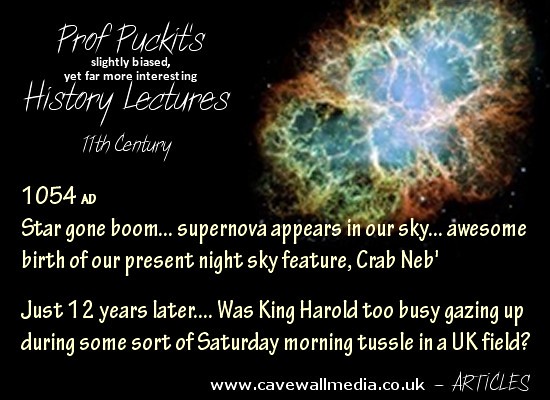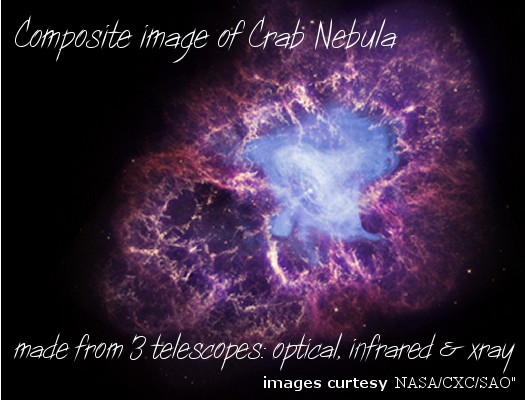Cave Wall Media – Articles » Slightly Biased History Lectures » Prof Puckit’s slightly biased history lectures – Crab Nebula
Prof Puckit’s slightly biased history lectures – Crab Nebula

In 1054 AD a supernova appeared in our skies, with such a brightness, it could be seen with the naked eye. It remained visible and static in its place amongst the other celestial bodies for around two years, after which time it had faded so no longer noticeable.
Very soon after, is the year 1066 AD, a year famous in UK schools history lessons, to teach about a certain tussle on a Saturday morning in some English field … A tussle now recalled as The Battle of Hastings.
This is the battle, in which King Harold was defeated. This battle is famous for the mention of King Harold having a truly bad day, with an arrow straight through the eye, being trampled by a horse, then becoming rather dead.
Here’s the ‘slightly biased, yet far more interesting history’ bit:
King Harold was in his thirties when the 1054 supernova flashed up in our skies, then glowed in the heavens, visible to the naked eye, for around two years.
Not long after, in his forties, was his 1066 Battle of Hastings……
With these dates being so close together, and my bias towards the universe being awesome to everyone…. I considered an attempt to blame H for not being focused on the task at hand because of having, strong in his mind, a heavenly distraction and this could create the desire to gaze upwards …. It’s based on a sort of health and safety oversight…. being, that it is dangerous to be gazing upwards whilst in a medieval battle zone, with archers present….. an oversight, just asking for an arrow in the eye.
“My Sire. The enemy has run away and you break us away from the safety and strategically advantageous position of the high ground and bring us down the hill…. then continue to stare to the heavens, uttering poetically, how beautiful a thing, it shall be.
My Sire. Tis wisdom to know and act upon the dangers of gazing continuously skyward, whilst in a battle zone…. being… yer-know…. a health n safety thingeth…. what with the possibilities of arrows…. n-all-that…. errrrrr, my Sire.”
HEY HO!…. OK, STOP THERE…… Just before outrage occurs…….. slightly made it up……..
• The bit about the enemy running away and the King’s men coming down the hill, is a true account….. The enemy changed tactics and pretended to run away, then when the King chased down from the safe and strategic high ground….. the enemy turned back at them…… A truly bad day for H….. and as mentioned earlier, the day did not get any better.
• The bit about looking skywards and being blamed for focusing more upon the heavens, than the task at hand, I hereby confess, is no more than a hint of rascal and mild mischief from myself……
This mischief, at this point, does however allow me to introduce a few bits of missing information, that will firstly, clear H of any mischievous accusations of negligence for star-gazing whilst in military duty…. and secondly, introduce the fact that the awesome celestial feature we today call the Crab Nebula, arrived in our skies, born from the 1054 supernova and so, to us…… was only 12 years old, in our heavens, as the 1066, Battle of Hastings, raged in a field below.
Awesome history of good recording, better measuring and future discovery = science.
The 1054 AD supernova in the sky, being so bright that it was visible to the naked eye for two years…. is true.
The Chinese have many records made at the time, recording the spectacle, the duration of it and more importantly, its precise position in the sky.
It was a bright, static object amongst their familiar celestial bodies, so they called it a “guest star”.
After the two years, the documents record it had dimmed and was no longer visible to the naked eye.
Once out of sight with the naked eye, it is a known fact that it is not visible anymore….. to anyone…. because the era of telescopes had not yet occurred.
This is the 11th Century and records of the invention and existence of telescopes were far later in history….. the early 17th Century.
Both the above key points, help to clear King Harold from star-gazing:
1. The 1054 supernova sighting was widely recorded in East Asia, but there are no ‘for sure’ documents of European sightings, so King Harold probably did not even know of its occurrence.
2. Once no longer visible with the naked eye, it is not possible, by anyone, to see, because telescopes were not invented.
…. So H is pretty much cleared of failure by any celestial distractions.
King Harold’s part in history, ended with a serious headache, in 1066 AD.
The 1054 AD supernova, however, continues to multiply in interest and be noted in history, as today’s science and technology, have allowed us to actually see more and more of what is out of sight just with the naked eye……
Thanks to the accurate records of the position of the 1054 supernova “guest star”…… hundreds of years later, newly invented telescopes were pointed towards that part of our skies….. and WOW!….. remnants of that 1054 supernova could be seen.
Here’s the subsequent timeline:
17th Century… telescopes invented and used for optical wavelength discoveries
18th Century… 1731 AD… John Bevis discovers ‘remnant’ (not yet associated as remnant of 1054 supernova)
19th Century… 1844 AD… ‘remnant’ named “Crab Nebula” by Lord Rosse
20th Century… 1921 AD… “Crab Nebula” identified as remnant of 1054 supernova, by Knut Lundmark
To date over the 20th and this early part of 21st Century have allowed the discovery of radio waves from it, and a pulsar within it.
In today’s exciting times of extraordinary images and general public access to these discoveries….. the Crab Nebula takes a center stage to be observed as it continues to develop…..
Here is a composite image made up from 3 of the latest 21st Century telescopes…… awesome!

Don’t just hear about history… with science you can be involved in learning, thinking, documenting, learning, thinking, documenting… yep typed twice…. =
= Discovering…. and Sharing Information for later…. and…. yep, Further Discovering o).
Q: What’s the date of The Battle of Hastings?
A: 12 years after the 1054 AD supernova appeared in our skies, the remnants of which give us our present night sky feature, the Crab Nebula.
Q: Did King Harold see the 1054 supernova?
A. Most probably not
Q: Could King Harold (or anyone) see the young Crab Nebula?
A: Impossible as no telescopes were invented until the 17th Century.
Q: Is acurate measuring, record keeping and technological invention useful?
A: Yep. In 1054 when the supernova appeared to the naked eye, acurate measurements of position were recorded. Centuries later a new invention, the telexcope, was pointed to the recorded position and what we today call the Crab Nebula was seen……. It was deduced / inferred / learned…… that a nebula is a remnant from a supernova event….. love science.
RIP King Harold…. Long live Crab Neb’…. Love science.
References and more reading:
https://articles.adsabs.harvard.edu//full/2003JAHH….6…46S/0000046.000.html
https://chandra.harvard.edu/photo/2009/crab/
https://www.middleages.org.uk/medieval-england
Article Sponsors & CWM’s Charity Support
Share this Post
Filed under: Slightly Biased History Lectures · Tags: Crab Nebula, Prof Puckit, Slightly Biased History Lectures













Use the tabs under the post – ‘Previous Post’ ‘Following Post’ – First Post’ ‘Latest Post’ – to move along the stories of Prof Puckit… in order of writing.
Or,
Use the CATEGORIES headings, in the top right column of page, to read all stories under the subject category.
* Use or Share… for a bit of education or intrigue.
Thanks
What an interesting, ‘far more interesting’!!! idea, to mix history happenings of different topics around a common date point.
It’s like a little healthy provocation type article, to stimulate a little flick around of thoughts and considerations.
Had to read it twice to tune into the quirky humour, but this made it amusing & always good when the word “history” is ever present.
What we can see nowadays, they then had no-idea about. What we’ll discover in future years is frightenly exciting.
The Crab Nebula is a tremendously interesting feature in our skies.
I’m sure article will help start some people to an interest in it and science, to record & discover. As said.
YES!!!! They knew nothing of what we see in the heavens today because telescopes did not even exist.
Wunder what we will discover as totally new, from now????
This article (History Lecture!) is a refreshing way of putting story and info over.
RIP King Harold, poor chap.
Long live Crab Nebula and and and and and telescope inventors
We all know “1066” and this was funny way to get science in there!
So true about importance of measuring, then later on (they had no idea) with the invention of telescopes we see and associate supernova with nebula.
Reckon King H may have seen similar pattern to our crab nebula when the arrow went through his eye!!!!! hee hee (LOL?)
What happened in 1066?
The battle of Hastings occured 12 tears after the supernova that created our todays Crab Nebula
I do believe :o)
Love science!
Original thinking. Jumping across subject areas with near dates is awesome idea. Makes engaging discussion in science and history. Thanks
Mike Palmer